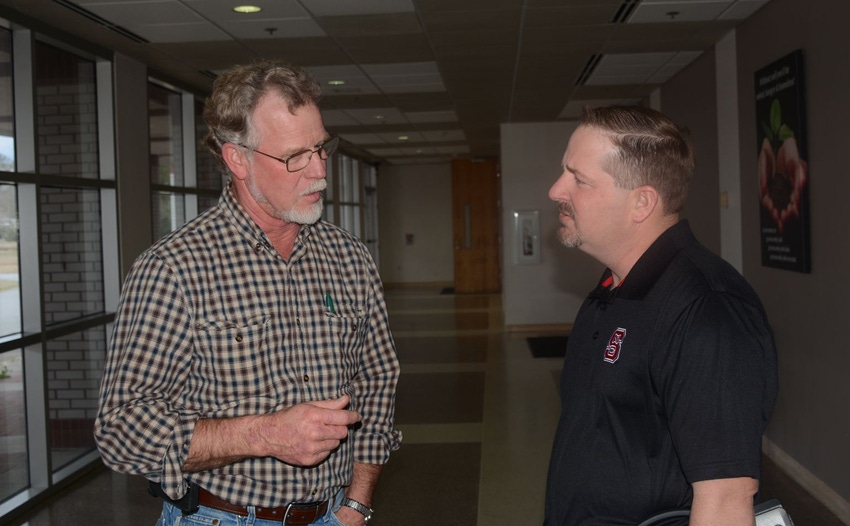
As Chad Poole sees it, most farmers in North Carolina’s Blacklands region started the 2016 growing season with soil and water conditions at ideal moisture levels to achieve Ron Heiniger’s “Year of the Corn” prediction in and garner record corn yields of 300 to 400 bushels per acre.
Unfortunately, the weather didn’t fully cooperate in North Carolina’s Blacklands last year. Heavy rain in May and then a dry and hot June and July put a hamper on yields in that part of the state. Poole, a research scholar in biological and agricultural engineering at North Carolina State University, notes that had control drainage been used, farmers in the Blacklands could have captured some of the excess water in May and used it in June and July when it was most needed
A proper drainage and water management system in the Blacklands is one of the keys to achieving top production goals, Poole emphasized at N.C. State’s Road Show Production meeting held at the Vernon James Research and Education Center in Plymouth, N.C.
Poole highlighted the prediction made by Heiniger, N.C. State Extension corn specialist, to emphasize the importance of water management. In meetings and field days in 2016, Heiniger said an El Nino weather pattern should create ideal growing conditions for maximum corn yields across North Carolina.
“Managing the available water resources is our responsibility,” Poole said at the road show meeting. “If we could have stored that 10.3 inches of runoff that we got in May and had it available in June or July, we may have made that 300 to 400 bushel mark. We didn’t have the water because we allowed it to drain out and we lost it.”
Poole said his collaborative research is looking at alternatives for farmers in North Carolina’s Blacklands to capture some of that excess water and use it when the crop most needs it. He pointed to long standing research in North Carolina that shows corn and soybean yields in the Blacklands can be increased by 10 percent on average if control drainage systems are in place to manage water.
Water management is vital in the Blacklands because the region gets an average of 45 inches to 55 inches of rain annually. Poole encourages farmers to look at their budget, do their homework and think long and hard about the drainage systems they need.
“Our open ditch drainage systems and networks in the Blacklands of North Carolina were designed to remove 2.5 inches of rain in a 24 hour period. If you do a cost effective tile design, you’re looking at removing anywhere from a half of inch to three quarter of an inch of subsurface water in a 24 hour period through the tile drains. In the Blacklands, we can get a three to four inch rainfall over a period of two to three hours,” Poole said.
That’s why farmers need to look at drainage systems that handle runoff water in these high intensity rainfall events. Farmers need to have a plan to remove excess surface water even with a subsurface tile drainage system installed, Poole stressed.
“A producer came to me a few years ago and said ‘we want to get rid of these ditches. We want to make it more efficient for our equipment and our large sprayers and planters. We want to be able to move our planter and not have to deal with ditches at the 200 to 300 foot mark. Can we do this and be effective?’”
Poole said it all depends on what farmers want to do with their surface water. Many farmers spend $20,000 to $25,000 per year in ditch maintenance and want to use a tile system to do away with the ditches.
“We know that in order to do away with these open ditches, we have to maintain the same level of drainage intensity that we have with ditches,” Poole explained. “To do that, we must have a well-designed subsurface tile system coupled with a good surface drainage system.”
Poole said a control drainage system allows farmers to hold water back when it is most needed by the plant. Tiles provide subsurface drainage. “The problem becomes the surface water,” he explained. “If we fill up those ditches, we don’t have a way of dealing with that water.”
In his research, Poole filled the ditches and replaced the ditches with shallow water furrows that were put in using lasers or RTK equipment. These furrows allow for excessive rainfall to be effectively removed as soon as it occurs.
Poole notes that the furrow design depth was to be a maximum of 18 to 20 inches while the effective rooting depth for water stress on soybeans, corn and wheat is about 12 inches. “When we add that furrow, we increased the ability to remove excess water in that 12 inch zone at a quicker rate. The furrow provides another safety net to deal with that excess water.”
Researchers in biological and agricultural engineering at N.C. State are looking at adding a holding pond to capture and hold excess water and pump the water back through the tile system when weather conditions become dry to hopefully boost yields. “This type of water reuse system would be very valuable during dry and hot periods similar to what occurred in 2016,” Poole said
About the Author(s)
You May Also Like






